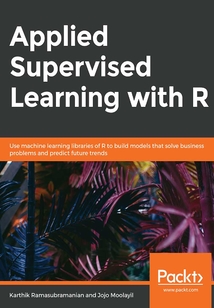舉報 

會員
Applied Supervised Learning with R
Rprovidesexcellentvisualizationfeaturesthatareessentialforexploringdatabeforeusingitinautomatedlearning.AppliedSupervisedLearningwithRhelpsyoucoverthecompleteprocessofemployingRtodevelopapplicationsusingsupervisedmachinelearningalgorithmsforyourbusinessneeds.Thebookstartsbyhelpingyoudevelopyouranalyticalthinkingtocreateaproblemstatementusingbusinessinputsanddomainresearch.Youwillthenlearndifferentevaluationmetricsthatcomparevariousalgorithms,andlaterprogresstousingthesemetricstoselectthebestalgorithmforyourproblem.Afterfinalizingthealgorithmyouwanttouse,youwillstudythehyperparameteroptimizationtechniquetofine-tuneyoursetofoptimalparameters.Topreventyoufromoverfittingyourmodel,adedicatedsectionwillevendemonstratehowyoucanaddvariousregularizationterms.Bytheendofthisbook,youwillhavetheadvancedskillsyouneedformodelingasupervisedmachinelearningalgorithmthatpreciselyfulfillsyourbusinessneeds.
目錄(137章)
倒序
- 封面
- 版權頁
- Preface
- About
- About the Book
- Chapter 1: R for Advanced Analytics
- Introduction
- Working with Real-World Datasets
- Reading Data from Various Data Formats
- Write R Markdown Files for Code Reproducibility
- Data Structures in R
- DataFrame
- Data Processing and Transformation
- The Apply Family of Functions
- Useful Packages
- Data Visualization
- Line Charts
- Histogram
- Boxplot
- Summary
- Chapter 2: Exploratory Analysis of Data
- Introduction
- Defining the Problem Statement
- Understanding the Science Behind EDA
- Exploratory Data Analysis
- Univariate Analysis
- Exploring Categorical Features
- Bivariate Analysis
- Studying the Relationship between Two Numeric Variables
- Studying the Relationship between a Categorical and a Numeric Variable
- Studying the Relationship Between Two Categorical Variables
- Multivariate Analysis
- Validating Insights Using Statistical Tests
- Categorical Dependent and Numeric/Continuous Independent Variables
- Categorical Dependent and Categorical Independent Variables
- Summary
- Chapter 3: Introduction to Supervised Learning
- Introduction
- Summary of the Beijing PM2.5 Dataset
- Regression and Classification Problems
- Machine Learning Workflow
- Regression
- Exploratory Data Analysis (EDA)
- Classification
- Evaluation Metrics
- Summary
- Chapter 4: Regression
- Introduction
- Linear Regression
- Model Diagnostics
- Residual versus Fitted Plot
- Normal Q-Q Plot
- Scale-Location Plot
- Residual versus Leverage
- Improving the Model
- Quantile Regression
- Polynomial Regression
- Ridge Regression
- LASSO Regression
- Elastic Net Regression
- Poisson Regression
- Cox Proportional-Hazards Regression Model
- NCCTG Lung Cancer Data
- Summary
- Chapter 5: Classification
- Introduction
- Getting Started with the Use Case
- Classification Techniques for Supervised Learning
- Logistic Regression
- How Does Logistic Regression Work?
- Evaluating Classification Models
- What Metric Should You Choose?
- Evaluating Logistic Regression
- Decision Trees
- XGBoost
- Deep Neural Networks
- Choosing the Right Model for Your Use Case
- Summary
- Chapter 6: Feature Selection and Dimensionality Reduction
- Introduction
- Feature Engineering
- One-Hot Encoding
- Log Transformation
- Feature Selection
- Highly Correlated Variables
- Feature Reduction
- Variable Clustering
- Linear Discriminant Analysis for Feature Reduction
- Summary
- Chapter 7: Model Improvements
- Introduction
- Bias-Variance Trade-off
- Underfitting and Overfitting
- Defining a Sample Use Case
- Cross-Validation
- Holdout Approach/Validation
- K-Fold Cross-Validation
- Hold-One-Out Validation
- Hyperparameter Optimization
- Grid Search Optimization
- Random Search Optimization
- Bayesian Optimization
- Summary
- Chapter 8: Model Deployment
- Introduction
- What is an API?
- Introduction to plumber
- A Brief History of the Pre-Docker Era
- Docker
- Amazon Web Services
- Introducing AWS SageMaker
- What is Amazon Lambda?
- What is Amazon API Gateway?
- Building Serverless ML Applications
- Deleting All Cloud Resources to Stop Billing
- Summary
- Chapter 9: Capstone Project - Based on Research Papers
- Introduction
- Exploring Research Work
- The mlr Package
- Problem Design from the Research Paper
- Features in Scene Dataset
- Implementing Multilabel Classifier Using the mlr and OpenML Packages
- Constructing a Learner
- Predictions
- Summary
- Appendix
- About
- Chapter 1: R for Advanced Analytics
- Chapter 2: Exploratory Analysis of Data
- Chapter 3: Introduction to Supervised Learning
- Chapter 4: Regression
- Chapter 5: Classification
- Chapter 6: Feature Selection and Dimensionality Reduction
- Chapter 7: Model Improvements
- Chapter 8: Model Deployment
- Chapter 9: Capstone Project - Based on Research Papers 更新時間:2021-06-11 13:23:01
推薦閱讀
- Svelte 3 Up and Running
- 嵌入式系統中的模擬電路設計
- VCD、DVD原理與維修
- Spring Cloud微服務架構實戰
- 超大流量分布式系統架構解決方案:人人都是架構師2.0
- 深入理解序列化與反序列化
- 龍芯自主可信計算及應用
- 筆記本電腦維修實踐教程
- 基于PROTEUS的電路設計、仿真與制板
- 3D Printing Blueprints
- The Artificial Intelligence Infrastructure Workshop
- 可編程邏輯器件項目開發設計
- UML精粹:標準對象建模語言簡明指南(第3版)
- Learning Less.js
- 筆記本電腦現場維修實錄
- Hands-On One-shot Learning with Python
- DevOps實戰:VMware管理員運維方法、工具及最佳實踐
- Hands-On Explainable AI(XAI) with Python
- 三菱FX2N系列PLC入門與應用實例
- 數字噴墨與應用
- CANoe開發從入門到精通
- 89C51單片機實用教程
- 阿里巴巴Java開發手冊(第2版)
- Intelligent Projects Using Python
- Spring Cloud微服務:入門、實戰與進階
- Learning Android Game Development
- 微型計算機接口技術
- Lumion 3D Cookbook
- Direct3D Rendering Cookbook
- 全圖解電腦軟硬件維修實用大全(視頻教程版、Windows 10適用)

